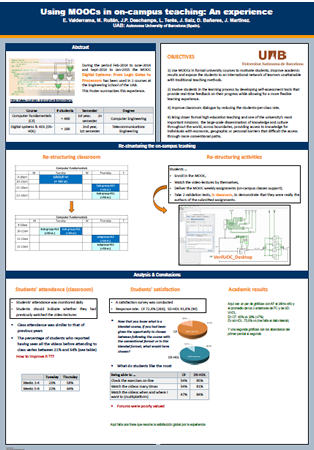Description
From February to June 2013, and from September 2013 to January 2014, the course 'Digital Systems: From Logic Gates to Processors' was used in a couple of undergraduate subjects in the Engineering School of the Autònoma University of Barcelona. The idea was to replace traditional teaching by the 'flipped classroom' approach, in which students learn the content online by watching video lectures, usually at home, and practical exercises are done in class, with teachers and students discussing and solving questions.
Our working hypotheses were that this approach would increase the students. involvement in their own learning process and so would improve the students. performance in terms of passing/failing the course.
To do so students were ask to enroll in the MOOC and the classroom hours, traditionally 2h per week in groups of 100 students and 1h per week in groups of 50 students were rearrange to work with a reduced number of students (50), without increasing the instructor's hours.
This blended approach was used in two subjects: Computer Fundamentals (CF), about 400 students, taught in the first year of the Computer Engineering degree, and in Digital Systems (DS), about 100 students, taught in the second year of the Telecommunications Engineering degree. In the last case, Coursera kindly allowed us to use a private version of the platform, only for our students.
Students had to:
- Enroll in the MOOC,
- Watch the video-lectures by themselves,
- Deliver the MOOC weekly quizzes. These quizzes were automatically corrected by using specific tailored software, VerilUOC_Desktop, so that students received instantly feedback about whether they were doing right or wrong. They had an almost unlimited number of attempts, but they were required to get a minimum score of 6.5.
- And take 2 validation tests, in classroom, to demonstrate that they were really the authors of the submitted assignments.
To further analyze the results of the course, (1) the students. attendance was tracked, (2) students were asked to report if they had seen the videos before coming class, and (3) a satisfaction survey was conducted. A detailed analysis of these data, together with the students. performance, is beyond the scope of this brief communication, but the most significant results are reported below:
- In the satisfaction survey the following question was put to students: .Now that the course is over, if you were given the opportunity to choose between following the course with the .conventional. format (3h per week of classroom plus homework) or in the .MOOC + classroom. format, which one would you choose?. The vast majority of students, between the 80% (CF) and the 90% (DS), declared that they would have chosen the blended approach.
- The tacking of the students. attendance to classrooms did not show any significant decrease compared with other subjects, contrary to what was one of our fears before starting the course.
- Viewing the videos before attending class was poor. Only 10% of students reported having seen all videos before attending the first class of the week (Tuesday), although this percentage rose to 53% in the second class of the week (Thursday). This is a point to improve, even though we do not have a clear idea about how to do it.
- Academic results, in terms of percentage of students passing the course, modestly increased (about a 7%) compared with the results obtained during the last 3 years.
- The blended approach clearly increases the students. retention rate. In average, during the last 3 years, the percentage of students dropping out the subject between the first and the second assessment was a 17% in CF and a 5% in DS, while these percentages fell to the 11% and 1% respectively within the blended approach.
So we conclude that, in the 2 courses here analyzed, students actually like this way of learning, and that the students. performance and retention rate improves when using the blended approach.
From the point of view of the instructor, data generated in the Coursera platform greatly facilitate the monitoring of teaching activity. These data provide a feedback to the instructor about the student. learning process that, in traditional classes, only can be acquired when the first assessments are evaluated, and usually then it's too late to change the way to conduct every topic.
We could also discuss some differences between the course of CF, conducted in parallel with the MOOC of Digital Systems, open to everyone and bilingual Spanish-English, and the course of DS, performed on a private_UAB version of the platform, but maybe the most significant difference has been the ability to perform, in the second case, a specific monitoring of our students. In this perspective, it would desirable that Coursera platform would allow the tracking of specific collectives within a course, generating differentiated data analytics whenever possible.
The blended approach used in the CF course was presented at the 2013 CIDUI(1) Congress held in Tarragona (Spain) in September 2013, although unfortunately communication is written in Spanish. An English version will be published at the JOTSE Journal.
(1) Congreso Internacional de Docencia Universitaria e Innovación http://www.cidui.org/. M. Rullán, E. Valderrama, JP Deschamps, L. Terés, D. Bañeres, J. Saiz. .Hacia un nuevo modelo docente: curso 'blended' de sistemas digitales. (ID 191, july 4 2013).
(2) Journal of Technology and Science Education http://www.jotse.org/index.php/jotse. To be published.
Comments? Collaboration ideas? Please feel free to send them.
Other UAB posters presented in the Coursera Partners Conference 2015
You can also view the poster on 'Economy of MOOCs: costs, benefits & strategy' presented by the UAB at the Partner's Conference 2015.
